Trans-Ulnar Vein Graft PCI in an Octogenarian-Juniper Publishers
JUNIPER PUBLISHERS-OPEN ACCESS JOURNAL OF CARDIOLOGY & CARDIOVASCULAR THERAPY
Abbreviations:
LIMA : Left Internal Mammary Artery; LAD: Left
Anterior Descending artery; ACS: Acute Coronary Syndrome; SVG: Saphenous
Vein Graft; PCI: Percutaneous Intervene; DES: Drug Eluting Stents
An 86-year-old gentleman was admitted to our cardiac
centre with chest pain and a troponin I rise to 4.85 ng/ml (normal value
< 0.03 ng/ml).His serial ECGs were unremarkable for any dynamic
changes. Significant past history included coronary artery bypass graft
in 1985 with presumed four grafts of unknown anatomy. Two years back, he
was admitted with a collapse secondary to complete heart block
requiring a permanent pacemaker. Coronary angiogram prior to pacemaker
insertion was challenging with failed femoral access on both sides.
Finally, angiography via left radial route revealed severe native vessel
disease and a patent vein graft to the left circumflex. The operators
were unable to incubate and visualize the left internal mammary artery
(LIMA) to left anterior descending artery (LAD) graft and the remaining
vein grafts despite multiple attempts with different catheters.
The diagnostic procedure at that time involved high
contrast load (300 ml of Visipaque) and hence the procedure was stopped
and the decision made to manage the patient medically. The patient’s
representation to us this time was managed as non-ST elevation acute
coronary syndrome (ACS). An echocardiogram revealed a normal left
ventricular ejection fraction (55-60%) and severe hypokinesia of the
antero-septal segments. After discussion with the patient, decision was
taken to repeat coronary angiography albeit keeping in mind pitfalls
from the previous procedure. The access site again posed a challenge for
us, as there were no femoral pulses palpable. Being a graft study, the
right radial artery was not attractive while the left radial artery was
barely palpable (used for access previously).
The only suitable remaining access site was the left
ulnar artery. Using the standard preparation technique for trans-radial
access, the left ulnar artery was punctured just proximal to the
pisiform bone with a 22-gauge needle and Merit 6F hydrophilic sheath was
inserted using standard Seldinger’s technique. Heparin 5000 U and
nitroglycerin 200 mcg was given as a cocktail through the sheath. The
left internal mammary artery (LIMA) was cannulated easily with 5F JR4
diagnostic catheter and was not a graft vessel (Figure 1). The right
coronary artery was non-dominant and chronically occluded. 5F AL-1
diagnostic catheter was used to visualize the left coronary system and
the vein grafts. The left coronary artery had severe native disease. The
saphenous vein graft (SVG) to left circumflex (obtuse marginal) was
patent with good distal run-off while another saphenous vein graft to
LAD (which was not seen before) had critical proximal sub-total
occlusion (likely culprit vessel) (Figures 2 & 3).
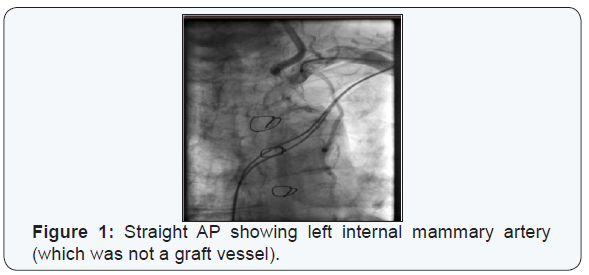
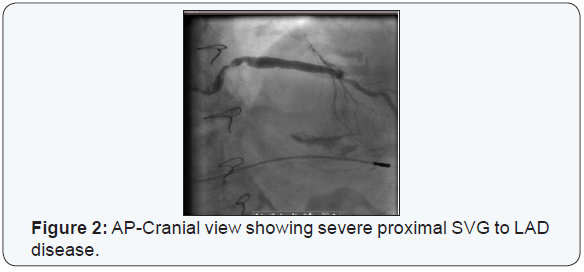

We decided to percutaneously intervene (PCI) on the
proximal SVG-to-LAD lesion. Using 6F AL1 guide, sion blue wire
crossed the lesion easily and the lesion was pre-dilated with
3x15 mm non-compliant balloon keeping in view the calcific
nature of the stenosis. Two Ultimate drug eluting stents (DES)
4x33 mm and 4x15 mm were deployed to cover the lesion up to
the ostium of the vein graft. Both were post-dilated with 4.5x12
and then 5x12 mm NC at 20 atmospheres. The final angiogram
showed some residual under-expansion due to heavily calcific
disease but otherwise excellent result (Figures 4-6). Transradial
band was applied over the left wrist. The ulnar artery was
patent by palpation at 1- and 7-day follow up.
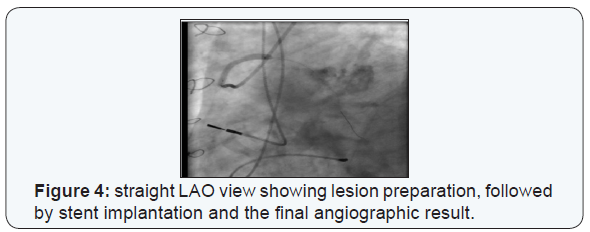
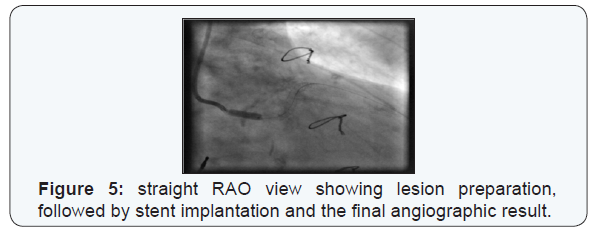
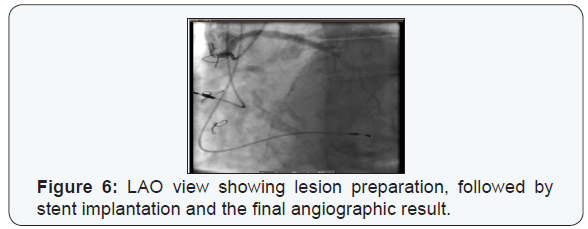
To the best of our knowledge, this is a unique case illustrating
left trans-ulnar vein graft PCI in an octogenarian in the context
of an ACS. The majority of trans-ulnar cardiac catheterizations
are diagnostic in nature and data is limited to only around 2,500
[1,2] since Terashima et al. [3] first published their experience
on nine patients more than a decade ago [3]. Only a limited
number of PCIs are being performed via the ulnar artery, mostly
for failed trans-radial access.
This includes failed radial artery puncture, radial artery loops
and curvatures, radial spasm or hypoplastic radial artery. Other
indication for performing a trans-ulnar cardiac catheterization
includes patients undergoing bypass surgery with use of radial
artery grafts. By far, it is still not a default route even for advanced
radial operators. Current ACC/AHA/ESC/SCAI guidelines (2011)
do not even mention the potential use of ulnar access for cardiac
catheterization and coronary interventions.
*The ulnar artery can be used as an alternative access for
vein graft PCI in patients not suitable for trans-femoral and
trans-radial approaches. Age and clinical presentation should
not hinder the procedure in appropriately selected patients.
It would be appropriate to establish a registry on all transulnar
PCIs so that all procedures are appropriately audited and
outcomes measured.
For more articles in Open Access Journal of Cardiology & Cardiovascular
Therapy please
click on:
https://juniperpublishers.com/jocct/index.php
https://juniperpublishers.com/jocct/index.php


Comments
Post a Comment